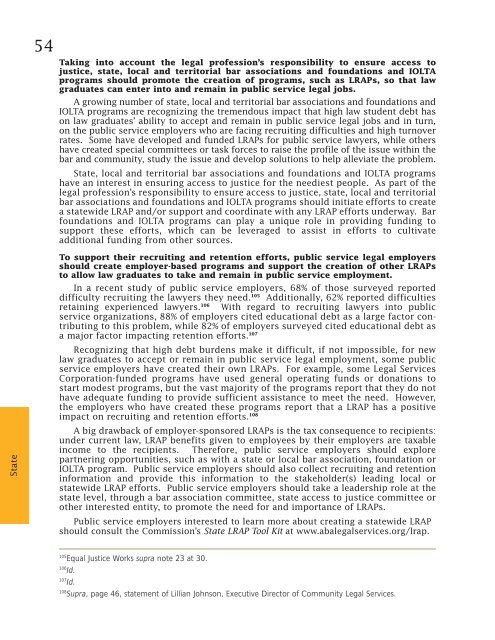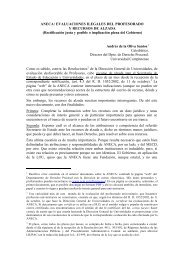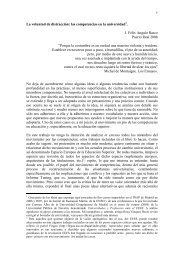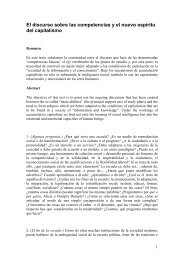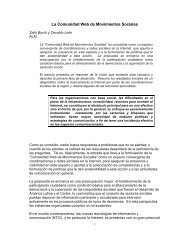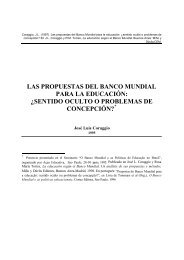Lifting the Burden: Law Student Debt as a Barrier to Public Service
Lifting the Burden: Law Student Debt as a Barrier to Public Service
Lifting the Burden: Law Student Debt as a Barrier to Public Service
You also want an ePaper? Increase the reach of your titles
YUMPU automatically turns print PDFs into web optimized ePapers that Google loves.
54Taking in<strong>to</strong> account <strong>the</strong> legal profession’s responsibility <strong>to</strong> ensure access <strong>to</strong>justice, state, local and terri<strong>to</strong>rial bar <strong>as</strong>sociations and foundations and IOLTAprograms should promote <strong>the</strong> creation of programs, such <strong>as</strong> LRAPs, so that lawgraduates can enter in<strong>to</strong> and remain in public service legal jobs.A growing number of state, local and terri<strong>to</strong>rial bar <strong>as</strong>sociations and foundations andIOLTA programs are recognizing <strong>the</strong> tremendous impact that high law student debt h<strong>as</strong>on law graduates’ ability <strong>to</strong> accept and remain in public service legal jobs and in turn,on <strong>the</strong> public service employers who are facing recruiting difficulties and high turnoverrates. Some have developed and funded LRAPs for public service lawyers, while o<strong>the</strong>rshave created special committees or t<strong>as</strong>k forces <strong>to</strong> raise <strong>the</strong> profile of <strong>the</strong> issue within <strong>the</strong>bar and community, study <strong>the</strong> issue and develop solutions <strong>to</strong> help alleviate <strong>the</strong> problem.State, local and terri<strong>to</strong>rial bar <strong>as</strong>sociations and foundations and IOLTA programshave an interest in ensuring access <strong>to</strong> justice for <strong>the</strong> neediest people. As part of <strong>the</strong>legal profession’s responsibility <strong>to</strong> ensure access <strong>to</strong> justice, state, local and terri<strong>to</strong>rialbar <strong>as</strong>sociations and foundations and IOLTA programs should initiate efforts <strong>to</strong> createa statewide LRAP and/or support and coordinate with any LRAP efforts underway. Barfoundations and IOLTA programs can play a unique role in providing funding <strong>to</strong>support <strong>the</strong>se efforts, which can be leveraged <strong>to</strong> <strong>as</strong>sist in efforts <strong>to</strong> cultivateadditional funding from o<strong>the</strong>r sources.StateTo support <strong>the</strong>ir recruiting and retention efforts, public service legal employersshould create employer-b<strong>as</strong>ed programs and support <strong>the</strong> creation of o<strong>the</strong>r LRAPs<strong>to</strong> allow law graduates <strong>to</strong> take and remain in public service employment.In a recent study of public service employers, 68% of those surveyed reporteddifficulty recruiting <strong>the</strong> lawyers <strong>the</strong>y need. 105 Additionally, 62% reported difficultiesretaining experienced lawyers. 106 With regard <strong>to</strong> recruiting lawyers in<strong>to</strong> publicservice organizations, 88% of employers cited educational debt <strong>as</strong> a large fac<strong>to</strong>r contributing<strong>to</strong> this problem, while 82% of employers surveyed cited educational debt <strong>as</strong>a major fac<strong>to</strong>r impacting retention efforts. 107Recognizing that high debt burdens make it difficult, if not impossible, for newlaw graduates <strong>to</strong> accept or remain in public service legal employment, some publicservice employers have created <strong>the</strong>ir own LRAPs. For example, some Legal <strong>Service</strong>sCorporation-funded programs have used general operating funds or donations <strong>to</strong>start modest programs, but <strong>the</strong> v<strong>as</strong>t majority of <strong>the</strong> programs report that <strong>the</strong>y do nothave adequate funding <strong>to</strong> provide sufficient <strong>as</strong>sistance <strong>to</strong> meet <strong>the</strong> need. However,<strong>the</strong> employers who have created <strong>the</strong>se programs report that a LRAP h<strong>as</strong> a positiveimpact on recruiting and retention efforts. 108A big drawback of employer-sponsored LRAPs is <strong>the</strong> tax consequence <strong>to</strong> recipients:under current law, LRAP benefits given <strong>to</strong> employees by <strong>the</strong>ir employers are taxableincome <strong>to</strong> <strong>the</strong> recipients. Therefore, public service employers should explorepartnering opportunities, such <strong>as</strong> with a state or local bar <strong>as</strong>sociation, foundation orIOLTA program. <strong>Public</strong> service employers should also collect recruiting and retentioninformation and provide this information <strong>to</strong> <strong>the</strong> stakeholder(s) leading local orstatewide LRAP efforts. <strong>Public</strong> service employers should take a leadership role at <strong>the</strong>state level, through a bar <strong>as</strong>sociation committee, state access <strong>to</strong> justice committee oro<strong>the</strong>r interested entity, <strong>to</strong> promote <strong>the</strong> need for and importance of LRAPs.<strong>Public</strong> service employers interested <strong>to</strong> learn more about creating a statewide LRAPshould consult <strong>the</strong> Commission’s State LRAP Tool Kit at www.abalegalservices.org/lrap.105Equal Justice Works supra note 23 at 30.106Id.107Id.108Supra, page 46, statement of Lillian Johnson, Executive Direc<strong>to</strong>r of Community Legal <strong>Service</strong>s.


